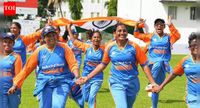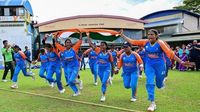The Indian women’s blind cricket team scripted an unforgettable chapter in sporting history this Sunday, November 23, 2025, clinching the inaugural Blind Women’s T20 World Cup with a commanding seven-wicket victory over Nepal at Colombo’s iconic P. Saravanamuttu Stadium. This wasn’t just a win—it was a statement, a flawless campaign that saw India dominate every opponent and finish the tournament unbeaten, a feat that’s sure to inspire generations of cricketers to come.
From the outset, India’s intent was clear. Captain’s luck shone at the toss, and the team opted to field first—a decision that paid off handsomely. The Indian bowlers, disciplined and relentless, kept Nepal under the thumb, restricting them to a modest 114 for 5 in their allotted 20 overs. Nepal’s batters struggled to break free, managing just a single boundary in the entire innings, a testament to India’s tight lines and sharp fielding. Sarita Ghimire was the lone bright spot for Nepal, holding the innings together with a patient 35 off 38 balls, but the Indian attack never let the scoring rate climb.
Blind cricket, for the uninitiated, is a marvel of adaptation and spirit. Played with a white plastic ball packed with ball bearings so it rattles audibly, the game requires bowlers to deliver underarm with at least one bounce, shouting “play” as they release the ball. Fielders clap once to reveal their positions, and every team must field at least four totally blind (B1) players, who wear blindfolds for fairness. The rest are partially sighted (B2 and B3), classified by how far they can see. In a unique twist, runs scored by B1 players count double, adding a fascinating layer of strategy.
As the chase began, India’s top order wasted no time. The run rate was brisk—India reached the 100-run mark in just 10 overs, keeping the pressure squarely on Nepal. The star of the show was Phula Saren, who delivered a match-winning performance that will be remembered for years. Saren smashed an unbeaten 44 off 27 balls, peppering the boundary with four stylish fours, and kept her cool as India coasted to 117 for 3 in just 12.1 overs. Her effort wasn’t just about the runs; it was about composure and leadership at the crease, setting the tone for the team’s triumph. Saren’s all-round contribution, including three overs for just 20 runs with the ball, earned her the well-deserved Player of the Match award.
India’s road to the title was nothing short of spectacular. The team opened their campaign by bowling out co-hosts Sri Lanka for a paltry 41, chasing it down in a mere three overs. Against Australia, India posted a mammoth 292 for 4, with Deepika TC scoring 91 and Saren adding a brisk 54 not out, before dismissing the Aussies for just 57—an eye-popping 209-run victory. The dominance continued as India swept aside Nepal in the league phase by 85 runs, chased down 136 against Pakistan in just 10.2 overs, and wrapped up the group stage with a 10-wicket win over the United States. In the semifinal, India outclassed Australia once again, this time by nine wickets, before sealing the trophy in style against Nepal.
The tournament itself was a milestone for the sport, co-hosted by India and Sri Lanka and featuring six teams: India, Nepal, Pakistan, Sri Lanka, Australia, and the United States. It began on November 11 in New Delhi, with matches also played in Bengaluru before the action shifted to Colombo for the knockouts and final. The event showcased not only India’s consistency but also the growing international reach and competitive spirit of blind women’s cricket.
Nepal’s journey to the final was no less dramatic. After a hard-fought group stage, they edged out Pakistan in a tense semifinal, setting up a showdown with the unbeaten Indian squad. While Nepal’s batters found the going tough in the final, their campaign will be remembered for resilience and moments of brilliance, especially from Sarita Ghimire, who anchored their innings under immense pressure.
The tournament also spotlighted individual excellence from across the globe. Pakistan’s Mehreen Ali, a B3 (partially sighted) player, finished as one of the stars of the competition, amassing over 600 runs, including a jaw-dropping 230 off 78 balls against Sri Lanka and a 133-run knock against Australia. Performances like hers underline the depth of talent and the competitive edge present in women’s blind cricket today.
Blind cricket’s unique rules add layers of complexity and excitement. The audible ball, underarm bowling, and fielders clapping to signal their positions create a game that’s as much about spatial awareness and teamwork as it is about skill. Each side must field a minimum of four totally blind players, and the rest are classified by visual acuity, ensuring a level playing field and a true test of adaptability. The format’s nuances—like B1 players’ runs counting double—bring tactical decisions to the fore, making every game a chess match as much as a contest of bat and ball.
This historic victory comes at a time when women’s cricket in India is on the rise across all formats. Barely three weeks before this triumph, the Indian women’s mainstream team had notched a landmark win over South Africa in Navi Mumbai. The dual successes underline the country’s growing depth and investment in women’s cricket, both for the sighted and visually impaired. Team India Women’s star and World Cup winner Jemimah Rodrigues even took to Instagram ahead of the final, urging the blind team to "make it 2 in 1 year girls!"—a rallying cry that resonated across the cricketing community.
The final at P. Saravanamuttu Stadium, Sri Lanka’s oldest Test venue, was a fitting stage for the conclusion of such a groundbreaking event. The atmosphere crackled with anticipation, and as India sealed victory with a boundary in the 13th over, the celebrations erupted—not just on the field, but among fans back home and across the cricketing world.
Looking ahead, India’s triumph is more than just a trophy in the cabinet. It’s a beacon for the future of women’s blind cricket, signaling a new era of recognition, opportunity, and inspiration for visually impaired athletes everywhere. With the sport’s profile on the rise and the Indian team setting the standard, the next generation of players has a shining example to follow.
As the sun set over Colombo and the Indian team lifted the trophy, the message was clear: the bar has been raised, and the world is watching. Here’s to more such moments, more heroes, and a future where women’s blind cricket continues to break barriers and capture hearts.


